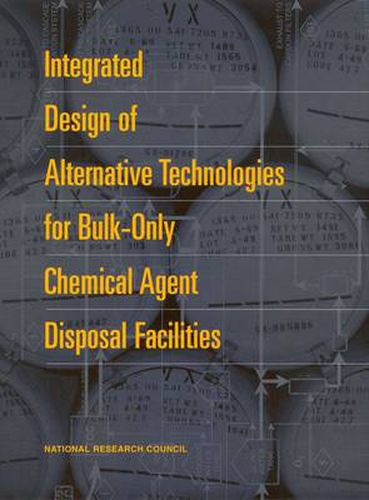Readings Newsletter
Become a Readings Member to make your shopping experience even easier.
Sign in or sign up for free!
You’re not far away from qualifying for FREE standard shipping within Australia
You’ve qualified for FREE standard shipping within Australia
The cart is loading…






The U.S. Army is pilot testing chemical hydrolysis as a method for destroying the chemical agents stockpiled at Aberdeen, Maryland (HD mustard agent), and Newport, Indiana (VX nerve agent). The chemical agents at both locations, which are stored only in bulk ton containers, will be hydrolyzed (using aqueous sodium hydroxide for VX and water for HD) at slightly below the boiling temperature of the solution. The resulting hydrolysate at Aberdeen, which will contain thiodiglycol as the primary reaction product, will be treated by activated sludge biodegradation in sequencing batch reactors to oxidize organic constituents prior to discharge to an on-site federally owned wastewater treatment facility. The hydrolysate at Newport, which will contain a thiol amine and methyl phosphonic acid as the major reaction products, is not readily amenable to treatment by biodegradation. Therefore, organic constituents will be treated using supercritical water oxidation (SCWO).
Integrated Design of Alternative Technologies for Bulk-Only Chemical Agent Disposal Facilities focuses on the overarching issues in the process designs integrating individual processing steps, including potential alternative configurations and process safety and reliability. This report reviews the acquisition design packages (ADPs) for the ABCDF and NECDF prepared by Stone and Webster Engineering Company for the U.S. Army.
$9.00 standard shipping within Australia
FREE standard shipping within Australia for orders over $100.00
Express & International shipping calculated at checkout
Stock availability can be subject to change without notice. We recommend calling the shop or contacting our online team to check availability of low stock items. Please see our Shopping Online page for more details.
The U.S. Army is pilot testing chemical hydrolysis as a method for destroying the chemical agents stockpiled at Aberdeen, Maryland (HD mustard agent), and Newport, Indiana (VX nerve agent). The chemical agents at both locations, which are stored only in bulk ton containers, will be hydrolyzed (using aqueous sodium hydroxide for VX and water for HD) at slightly below the boiling temperature of the solution. The resulting hydrolysate at Aberdeen, which will contain thiodiglycol as the primary reaction product, will be treated by activated sludge biodegradation in sequencing batch reactors to oxidize organic constituents prior to discharge to an on-site federally owned wastewater treatment facility. The hydrolysate at Newport, which will contain a thiol amine and methyl phosphonic acid as the major reaction products, is not readily amenable to treatment by biodegradation. Therefore, organic constituents will be treated using supercritical water oxidation (SCWO).
Integrated Design of Alternative Technologies for Bulk-Only Chemical Agent Disposal Facilities focuses on the overarching issues in the process designs integrating individual processing steps, including potential alternative configurations and process safety and reliability. This report reviews the acquisition design packages (ADPs) for the ABCDF and NECDF prepared by Stone and Webster Engineering Company for the U.S. Army.